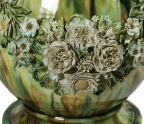City of Hobart Art Prize: Tasmanian Museum and Art Gallery

Every five years – for the last 15 – the City of Hobart Art Prize affords the ceramic medium a moment in the sun, and 2015, my first back home for a decade or so, was one such year. Still grappling with reverse culture shock, I ventured into the newly revamped Tasmanian Museum and Art Gallery (TMAG) to view the exhibition. Not only has the entrance been moved and dinosaur skeleton relocated to the reception veranda but the various galleries in the sandstone warren have also been shuffled. I was lost in a space once familiar. So, like many of the tourists that drift this far south, I inquired as to the whereabouts of the art prize exhibition and was duly directed past the blue carpet.
The City of Hobart Art Prize is an acquisitive one for work in two mediums that change every year. Previous winners in the ceramic section were Gerry Wedd (in 2010) with a composition of environmental concern that borrowed its title from Rachel Carson’s ecological critique. , was honed from the detritus observed during city meanderings and made into casts of dead birds from unknown
You’re reading a preview, subscribe to read more.
Start your free 30 days





